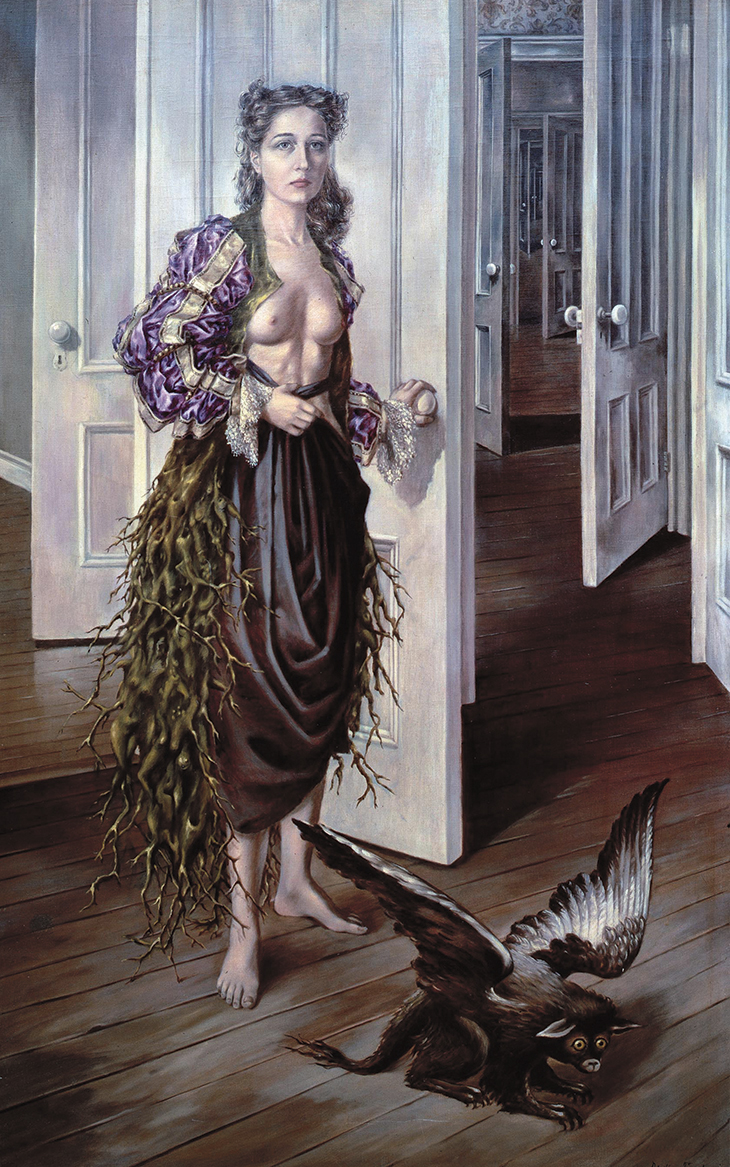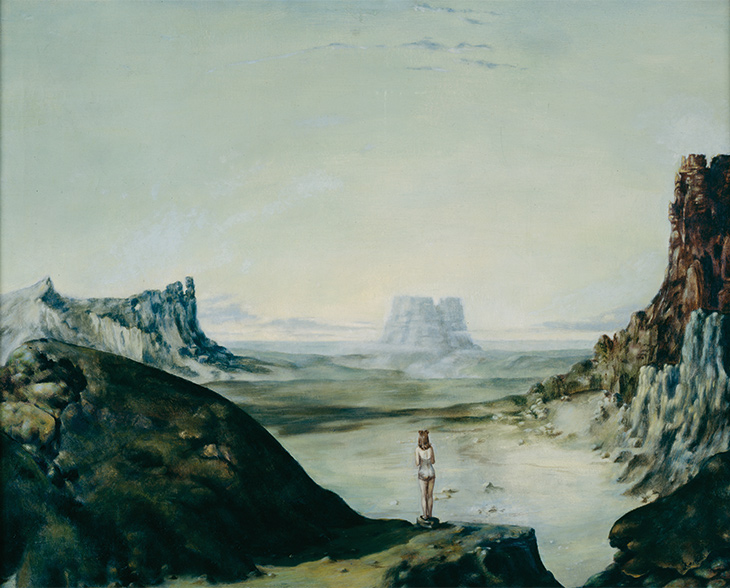Dorothea Tanning first saw the work of the European Surrealists at ‘Fantastic Art, Dada, Surrealism’, an exhibition organised by Alfred Barr at MoMA in 1936. Her enthusiasm for their work – wholly new to American eyes – led her to France three years later, aged 29, with letters of introduction to Picasso, Max Ernst and others. Her trip was cut short by the outbreak of war in September, but on her return to New York, where most of the Surrealists soon fled, Tanning began to incorporate what she had seen into her own work: strange and fantastic scenes with otherworldly protagonists, sometimes taking off from, and deconstructing, the commercial art she was making for companies such as Macy’s department store. It was through the art director of Macy’s that Tanning was introduced to Julien Levy, whose gallery was showing the work of the émigré Surrealists. Levy advised Ernst, then married to Peggy Guggenheim, that Guggenheim might consider including Tanning in her exhibition of women artists.
The show ‘31 Women’ opened at the Art of This Century gallery in 1943 with two works by Tanning: Birthday, perhaps her first successful Surrealist work, and Children’s Games (both 1942). Birthday shows Tanning in dishevelled, archaic dress – perhaps Elizabethan – breasts bared, her skirt covered with a mantle of twigs or roots, some of them shaped like bodies. She stands with one hand on an open door that leads on to other open doors and still more open doors, while at her feet sits a mysterious furred and winged creature. It is an accomplished painting and an ambiguous one. Tanning’s pensive gaze, her hands clutching door handle and falling skirt, the series of ever-opening doors: all seem to indicate that we are witnessing a woman on the verge of some transgression – or protecting herself from one. It is a very different work from its sister painting in Surrealist self-declaration, Leonora Carrington’s Self-Portrait of c. 1937–38 (which Tanning likely saw in New York), in which Carrington faces the viewer combatively, wild-haired, confident and androgynous, accompanied by her hyena familiar.
Birthday (1942), Dorothea Tanning. Philadelphia Museum of Art. © DACS, 2018

For both artists Surrealism was a means of escaping the rigidity and stifling religiosity of their childhood homes. Tanning, who was brought up the child of Lutheran Swedish immigrants in the small town of Galesburg, Illinois, later said that there ‘nothing happened but the wallpaper’. It is not a surprise, then, to see in Children’s Games two girls ripping the grey paper from the walls – exposing body parts of adult women beneath – while a third girl lies half out of view, collapsed, only her feet and a strip of wallpaper visible in the bottom corner of the canvas (Tanning was one of three sisters). Pubescent angst and reverie is also the subject of the famous work Eine Kleine Nachtmusik (1943), acquired by the Tate in 1997, which shows two young girls in the corridor of a hotel. One leans against a doorframe, eyes closed and blouse undone, while the other contemplates a gigantic sunflower lying on the floor. Have the girls somehow conjured or engorged this monstrous bloom? The hair of the second girl, which rises upright into the air, suggests some power transmitted between them, a surge of fertile electricity, while the yellow light coming from an open door at the end of the corridor (the motif of the open window or light at the end of the tunnel recurs in her early work) is here at once hopeful and trepidatious.
Self-Portrait (1944), Dorothea Tanning. San Francisco Museum of Modern Art. Photo: Katherine Du Tiel; © DACS, 2018

Tanning saw herself as on the cusp of something – a self-portrait from 1944 shows her looking out to a distant hill or citadel, a tiny figure in a vast and rocky landscape. In 1946 she married Ernst and the couple moved to Sedona in Arizona, where she painted in a ‘two-hundred-square-foot (about) rectangular space, where the temperature hovered around ninety degrees and sometimes made me cry’. Of the paintings from this period included in the Tate Modern retrospective – the first major exhibition of her work for 25 years, previously at the Museo Reina Sofía, Madrid – it is Maternity (1946–47) that stands out. A woman, dressed in white, holds her child in a desert landscape. Both wear expressions of extreme consternation, and are swaddled in a white fabric that makes the image more monastic than Madonna-like. Their suffering – which has been read as an indictment of motherhood by the childless Tanning – is made grotesque by the smiling, human-faced Pekingese beside them.
Like many Surrealists, Tanning seems to have seen painting as a means to an end in her early work, and it is in their more graphic aspects that her paintings are most successful visually. She had a great feeling for form, for folds and angles, cloth and clouds, often sharpening the edges of her drapery until it looked like crenulated rock. In The Guest Room (1950–52), the curtain that so often frames portraits inertly here takes on a life of its own, not only rising up above the scene but breaking through the open door to swirl over the head of the young nude protagonist. Tanning’s delight in this vaporous quality became the major force in her work in the late 1950s and ’60s, by which time she and Ernst were living in France; it led to a series of amorphous paintings in which figures and forms appear and disappear in a melee of shape and colour. They are not the most successful works at Tate Modern, which has perhaps been too dutiful in giving us the full sweep of Tanning’s uneven career (she died in 2012, aged 101).
Nue couchée (Reclining Nude) (1969–70), Dorothea Tanning. Tate Collection. © DACS, 2018

But there are revelations to be had in her later work, particularly in the ‘soft sculptures’ that she felt compelled to make after hearing Stockhausen’s Hymnen in 1969. Here, in work prefiguring Louise Bourgeois’ later turn to similar forms, Tanning sewed and stuffed humanoid shapes in cotton and tweed, filling them with wool cardings, tennis balls – anything that came to hand. Nue Couchée (1969–70) begins as the supine back of some Venus – buttocks, hips, spine – but the waist opens out into three limb-like protrusions, folding and crossing each other. Most unsettling of all is Chambre 202, Hôtel du Pavot (1970–73), inspired in part by a song about the suicide of a gangster’s wife (‘In room two hundred and two / The walls keep talking to you’). The installation – a room with wooden floor and dark-patterned wallpaper – is inhabited by fabric forms that emerge from the furniture and break through the walls, echoing and fully realising the motif of Children’s Games 30 years earlier. In these works we see a thoroughly modern Tanning, whose openness to the new allowed her to maintain her allegiance to Surrealism in its deeper sense, as – in her own words – an ‘effort to plumb our deepest subconscious to find out about ourselves’.
‘Dorothea Tanning’ is at Tate Modern, London, until 9 June.
From the April 2019 issue of Apollo. Preview and subscribe here.



